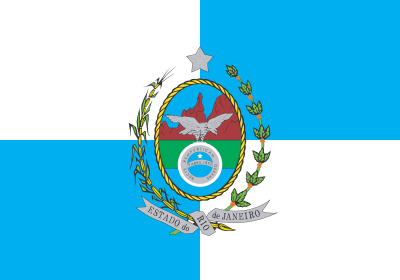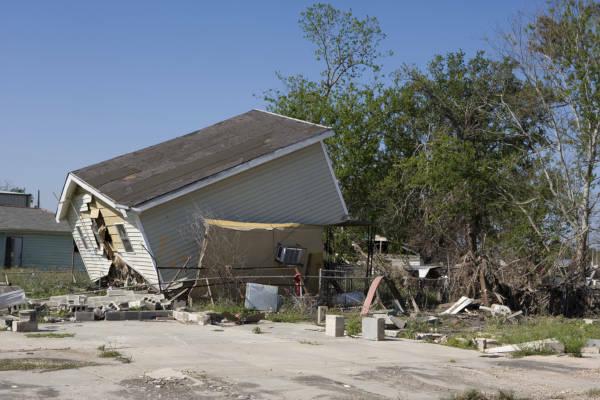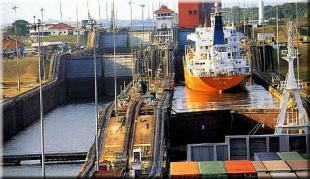The State of Rio de Janeiro is located in the Southeast region. The capital is Rio de Janeiro. Those born in the state are called fluminense. Those who are born in the city are called carioca.
THE acronym of the state is RJ and the population is approximately 16.5 million inhabitants, according to the IBGE (Brazilian Institute of Geography and Statistics). The state has 92 municipalities distributed in an area of 43,777,954 square kilometers.
 Flag of the State of Rio de Janeiro
Flag of the State of Rio de Janeiro
History
The state is among the first to be colonized by the Portuguese, who docked at Guanabara Bay on January 1, 1502, in an exploratory expedition. It is for this reason that it was named Rio de Janeiro.
The colonization process began in 1531, with the disembarkation of Martim Afonso de Souza. The settlers' expedition was driven by threats from the French, Dutch and English.
These nations participated late in the great navigations and began to invade Brazilian territory.
The constant invasions motivated King Dom João III to divide Brazil into 15 hereditary captaincies that were distributed to 12 noblemen.
The territory that is currently occupied by the State of Rio de Janeiro belonged to the Captaincy of São Vicente. The area was handed over to Martim Afonso de Souza in 1534. The area of São Tomé was also part of the territory, which was donated to Pero Góis da Silveira in 1536.
The Guanabara Bay region was invaded in 1555 by a French expedition. There, they founded Antarctic France, where 300 Calvinist colonists were sent.
The reaction of the Portuguese Crown against French invasions begins in 1565. The process takes place with the foundation of the city of São Sebastião in Rio de Janeiro, on March 1st, under the command of Estacio de Sa. This was the second city founded in Brazil.
Successive battles between the Portuguese and the French and the indigenous took place in 1567 and 1568. In battles like these, the Brazilian indigenous population was practically decimated.
Indians who allied with the Portuguese were rewarded. This was the case of Arariboia, leader of the Temiminos, who received the area now occupied by the city of Niterói as a reward for the fight against the French.
As a strategy to manage the onslaught of European enemies, the Portuguese divided Brazil into two governments in 1574. The general governments were headquartered in Salvador, Bahia, and the city of Rio de Janeiro.
From that point onwards, the definitive occupation of the region takes place. The reunification of the territory only takes place in 1578, with the capital being headquartered in Salvador.
After the arrival of the Portuguese court, in 1808, Rio de Janeiro became the capital of Brazil and belonged to the State of Guanabara. This condition lasted until the foundation of the current capital, Brasília (DF), on April 21, 1960.
With the transfer of the Federal District to the Midwest, the area of the current city of Rio de Janeiro became an independent city-state. This condition lasted from 1960 to 1975, when the city of Rio de Janeiro was united with the State of Rio de Janeiro and became the capital. This is the current political-administrative organization.
Understand the subject better by reading the articles:
- Hereditary Captaincies
- General Government
- Tome de Souza
- Sesmarias
Economy
The State of Rio de Janeiro has the second largest economy in Brazil. It is responsible for 12.6% of the Brazilian GDP (Gross Domestic Product).
Oil extraction is the main source of income for the state. In second place is the manufacturing industry and, finally, commerce and services.
Industrial production is centered on steel alloys, flexible tubes, automotive engines, cosmetics, tires and polypropylene. There are also fuel and lubricant industries for aircraft, diesel, biodiesel, medicines and others.
Major cities
The cities in the state have tourist and economic importance depending on the region where they are located. In the coastal region, which is called Costa do Sol, are Búzios, Cabo Frio, Arraial do Cabo, Rio das Ostras, Maricá and Saquarema.
In the mountainous region are Petrópolis, Teresópolis and Nova Friburgo. Among them, Petrópolis has a special architecture and was chosen for the summer holidays of Dom Pedro II.
The most important city is the capital, Rio de Janeiro. The city is a historical, economic and tourist highlight.
Attractions
The city of Rio de Janeiro is the main attraction for visitors to the region and the country.
In addition to the beaches, the best known are Copacabana, Leblon and Ipanema, there is the Sugar Loaf Mountain and the Christ the Redeemer. The sites are visited by thousands of tourists every year.
Combined with the range of natural beauties, the city offers the historical equipment left behind by the permanence of the Portuguese Court in Brazil. Among them are the National Library, the Municipal Theater and several museums.
Keep studying! Read too:
- Southeast region
- Southeastern States
- Southeast culture
- Climate of the Southeast Region
- Southeast Region Economy
- Brazilian Regions
- Brazil states
- Acronyms of Brazilian States


